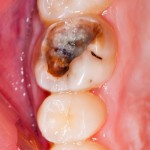
Management of dental caries traditionally involves the removal of all softened and demineralised dentine. This approach increases the risk of pulpal exposure, particularly in deeper cavities. More conservative minimal approaches to caries management involving a range of partial caries removal approaches have been the subject of a growing body of research.
The aim of this study was to present the 5-year follow-up of step wise caries removal in deep carious lesions in permanent teeth.
Methods
Patients aged 18 years or above with a primary carious lesion radiographically involving more than or equal to three-fourths of the dentin with a well-defined radio dense zone between the carious lesion and the pulp were eligible. They were randomly allocated to receive either step wise carious removal or non-selective carious removal to hard dentine.
Stage 1 of the step wise procedure involved the selective removal of necrotic and demineralised dentine and non-selective removal of peripheral dentine until a temporary restoration could be placed. Stage 2 was carried out at 8-12 weeks where non-selective removal to hard dentine was undertaken before placing the final restoration.
The non-selective group had their caries removal undertaken at the first visit and a base material and temporary restoration placed. The temporary restoration but not base material was replaced at 8-12 weeks.
If excavations resulted in pulp exposure suitable patients were randomised to one of two pulp capping procedures. At follow up tooth vitality was assessed using thermal methods, ethyl chloride and electric pulp testing. The main outcomes were pulp vitality and periapical radiolucency. Success was defined as, unexposed pulps with sustained vitality without apical radiolucency
Results
- 314 patients were randomised (156 step wise; 158 non-selective).
- at 5-years 239 (76%) patients were reviewed (118 step wise; 121 non-selective).
- Medium observation time was 5.0 y (95% CI, 4.7–5.1 y) in the step wise group and 4.5 y (95% CI, 1.5–5.0 y) in the non-selective group.
- There was a statistically significant difference in the success rate at 5 years in the step wise group (62.2% ) compared with the non-selective group (46.3%).
- 21.2% of teeth had a pulp exposure in the step wise group compared with 35.5% in the
- 58 patients were randomised to the nested pulp capping trial – no statistically significant differences in outcomes were seen.
Conclusions
The authors concluded: –
Taking the limitation of the study into account, the step wise carious removal procedure has a significantly higher proportion of pulps with preserved vitality without apical radiolucency versus non-selective carious removal of deep caries lesions in adult teeth at 5-y follow-up. Age is not influencing the treatment outcome in non-exposed treatment, supporting the point of avoiding pulp exposure. Pulp-capping procedures might be a dubious treatment in adults with well-defined deep caries.
Randomized clinical trials are needed to expand the evidence of whether a selective carious removal is to be preferred to a 2-stage step wise removal of deep carious tissue.
Comments
When the 2013 Cochrane review by Ricketts et al on operative caries management in adults and children (Dental Elf – 19th Sep 2013 ) they concluded that:-
Stepwise and partial excavation reduced the incidence of pulp exposure in symptomless, vital, carious primary as well as permanent teeth. Therefore these techniques show clinical advantage over complete caries removal in the management of dentinal caries.
A 2016 review by Hoefler et al (Dental Elf – 9th Nov 2016) included 5 studies two of which were RCTs and suggested that there was limited evidence of fewer pulpal complications at 3 years. One of the recommendations of the Cochrane review was for further long term clinical trials. This current study reports on the 5 years follow up data from one of the studies (Bjørndal et al 2010) included in the Cochrane review and the findings suggest a continuing positive outcome from the step wise approach to caries removal.
Links
Primary paper
Bjørndal L, Fransson H, Bruun G, Markvart M, Kjældgaard M, Näsman P,Hedenbjörk-Lager A, Dige I, Thordrup M. Randomized Clinical Trials on Deep Carious Lesions: 5-Year Follow-up. J Dent Res. 2017 Apr 1:22034517702620. doi: 10.1177/0022034517702620. [Epub ahead of print] PubMed PMID: 28410008.
Other references
Bjørndal L, Reit C, Bruun G, Markvart M, Kjældgaard M, Näsman P, et al. Treatment of deep caries lesions in adults: randomized clinical trials comparing stepwise vs. direct complete excavation, and direct pulp capping vs. partial pulpotomy. European Journal of Oral Sciences 2010;118(3):290-7.
Dental Elf – 19th Sep 2013
Partial removal of caries as effective as stepwise removal in deep cavities
Dental Elf – 9th Nov 2016
Stepwise and partial-caries-removal –reduces longer term pulpal complications?

[…] Step wise caries removal sustained pulp vitality up to 5 years […]